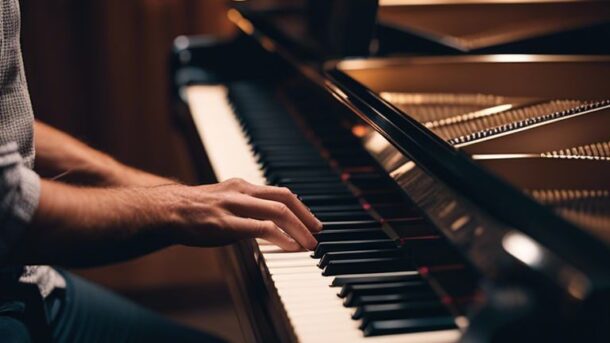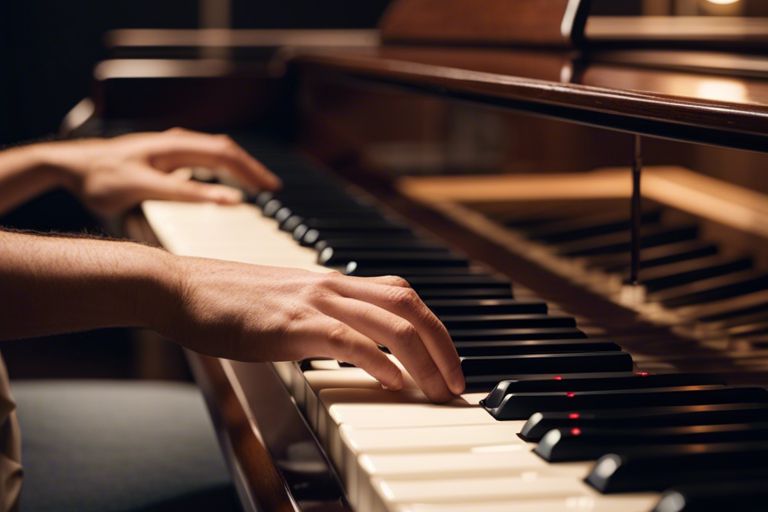Overwhelmed by the abundance of online options for learning the piano and keyboards? Don’t worry, we’ve got you covered! In this guide, we’ll walk you through some of the best online resources available to help you tune up your musical skills. Whether you’re a beginner looking to learn the basics or an intermediate player aiming to refine your technique, these platforms offer a variety of lessons, tutorials, and exercises to suit your learning style and pace. Let’s dive in and explore the virtual world of piano and keyboard education!
Key Takeaways:
- Online courses: Utilize platforms like Udemy, Coursera, and Skillshare for comprehensive piano and keyboard lessons.
- YouTube tutorials: Take advantage of countless free tutorials from professional pianists and instructors on YouTube.
- Interactive apps: Explore apps like Simply Piano, Yousician, and Playground Sessions for personalized learning experiences.

Online Learning Platforms
While there are many online resources available for learning piano and keyboards, online learning platforms offer structured lessons, interactive features, and often access to instructors. These platforms provide a comprehensive approach to learning music theory, techniques, and repertoire.
Websites with Interactive Lessons
Learning through websites with interactive lessons can be a great way to engage with the material actively. Many sites offer step-by-step lessons that allow you to progress at your own pace. Interactive features like virtual keyboards, visual aids, and quizzes can enhance your learning experience and make practicing more enjoyable.
Mobile Apps for Piano Learning
Mobile apps have revolutionized the way we learn, and piano learning is no exception. With mobile apps specifically designed for piano learning, you can have access to lessons, practice tools, and even feedback right at your fingertips. Whether you’re a beginner looking to get started or an experienced player wanting to improve your skills, there’s a mobile app out there for you.
It’s crucial to choose apps that suit your learning style and goals. Some apps focus on teaching basic techniques and music theory, while others offer a variety of songs to play along with. Look for apps that provide a good mix of instruction, practice, and fun to keep you motivated on your piano learning journey.
Video Tutorials and Channels
Even in today’s digital age, video tutorials remain one of the most popular ways to learn the piano and keyboards. The visual and auditory cues provided by these resources make it easier for you to grasp complicated techniques and concepts. Whether you are a complete beginner or looking to improve your skills, there are numerous online platforms offering valuable content to help you on your musical journey.
YouTube Channels for Piano Beginners
YouTube is a goldmine for piano beginners, offering a plethora of channels dedicated to teaching you the basics of playing the piano. Channels like Pianote and Playground Sessions cater specifically to beginners, breaking down complex topics into easy-to-follow lessons. These channels often provide step-by-step tutorials, practice exercises, and tips to help you progress at your own pace.
Online Courses with Video Lessons
Any aspiring pianist can benefit from enrolling in online courses that offer video lessons. Platforms like Udemy and Coursera host a variety of courses taught by professional instructors, covering everything from fundamental techniques to advanced music theory. These courses typically come with structured lesson plans, quizzes, and assignments to track your progress and ensure you are grasping the material effectively.
Courses with video lessons give you the flexibility to learn from the comfort of your own home and at your own pace. Additionally, they often provide a sense of community through discussion forums where you can interact with instructors and fellow students, creating a well-rounded learning experience.
Sheet Music and Scores
Websites with Free Sheet Music
Your journey to learning the piano or keyboard can be greatly enhanced by accessing free sheet music online. Websites like MuseScore, IMSLP (International Music Score Library Project), and 8notes offer a vast collection of sheet music for various skill levels. By exploring these resources, you can expand your repertoire and practice a diverse range of pieces without spending a dime.
Online Stores for Digital Sheet Music
Online stores such as Sheet Music Plus and Musicnotes provide a wide selection of digital sheet music for purchase. These platforms cater to musicians of all levels and offer the convenience of instant download, allowing you to access new pieces quickly and easily. Whether you’re looking for classical masterpieces, contemporary hits, or educational materials, these online stores have a wealth of options to enhance your learning experience.
It’s worth noting that digital sheet music often comes with added features like transposition options, audio playback, and interactive tools that can aid in your practice sessions. Additionally, these online stores frequently offer discounts, sales, and subscriptions that can help you save money while building your music library.
Practice Tools and Software
Virtual Keyboards and MIDI Editors
Virtual keyboards and MIDI editors are excellent tools for practicing piano and keyboard skills. They allow you to practice without needing an actual instrument, making them perfect for when you’re on the go or don’t have access to a piano. With virtual keyboards, you can work on finger placement, learn scales and chords, and practice playing along with songs. MIDI editors also enable you to create and edit music, making the learning process more interactive and engaging.
Metronome and Tempo Adjustment Tools
Practice your timing and rhythm with metronome and tempo adjustment tools. These resources help you stay on beat and develop a sense of timing critical for piano playing. By setting the tempo to different speeds, you can gradually increase the difficulty of your practice sessions, improving your dexterity and precision. Consistent use of metronomes and tempo adjustment tools can significantly enhance your playing abilities, helping you become a more well-rounded pianist.
Metronome and tempo adjustment tools are invaluable for any musician looking to improve their playing. They provide a solid foundation for your practice sessions and are necessary for mastering complex pieces that require precision and accuracy. Incorporating these tools into your daily practice routine will yield noticeable improvements in your piano skills over time.
Software
Utilize software programs that offer features such as interactive lessons, music theory instruction, and virtual keyboards to enhance your learning experience. These tools can help you track your progress, identify areas for improvement, and provide guidance on how to advance your skills. Whether you are a beginner or an experienced player, incorporating piano and keyboard software into your practice routine can take your musical journey to the next level.

Community and Forums
Many online resources offer vibrant communities and forums where piano enthusiasts can connect, share tips, and seek advice from fellow learners and experts in the field.
Online Forums for Piano Enthusiasts
With online forums dedicated to piano playing, you can engage with a community of like-minded individuals who are passionate about music. These forums provide a platform to ask questions, discuss practice strategies, and even seek recommendations for learning materials or online courses. By participating in these forums, you can benefit from the collective knowledge and experience of the community, which can be invaluable in your piano learning journey.
Social Media Groups for Piano Learners
Community-driven social media groups focused on piano learning are another excellent resource for connecting with fellow piano enthusiasts. Platforms like Facebook, Reddit, and LinkedIn host groups where you can share your progress, watch performances from other members, and engage in discussions on various piano-related topics. These groups can serve as a source of motivation, inspiration, and camaraderie as you navigate the intricacies of learning to play the piano.
Piano learning is not just about practicing scales and chords; it’s also about connecting with a community that shares your passion for music. Social media groups provide a more casual setting compared to traditional forums, allowing you to interact with other learners in real-time, share videos of your playing, and receive instant feedback from a supportive network of fellow piano enthusiasts.
Paid Resources and Courses
After What is the best online resource to learn the piano?, you might be eager to explore paid resources and courses to enhance your piano and keyboard skills. These paid options often offer more structured learning paths and personalized attention to help you progress efficiently and effectively.
Online Courses with Personalized Feedback
For those looking to receive individualized guidance and feedback on your piano playing, online courses with personalized feedback could be a valuable investment. These courses typically involve submitting recordings or videos of your playing to instructors who then provide detailed assessments and recommendations for improvement. This personalized approach can help you identify and work on specific areas of your playing that need attention, leading to faster progress and a deeper understanding of music theory and technique.
Private Lessons with Experienced Teachers
Courses that offer private lessons with experienced teachers are a popular choice for those seeking a more hands-on and tailored learning experience. With private lessons, you can work one-on-one with a skilled instructor who can personalize the curriculum to suit your goals and learning style. Whether you’re a beginner looking to build a strong foundation or an intermediate player aiming to refine your skills, private lessons offer the opportunity to receive direct feedback, guidance, and support from a knowledgeable mentor.
With private lessons, you can also benefit from the instructor’s expertise in helping you overcome challenges, learn new techniques, and gain insights that can elevate your playing to the next level. The structured nature of private lessons ensures that you stay motivated and accountable in your practice, making steady progress towards your musical goals.

Conclusion
From above, you can now see that there are numerous high-quality online resources available to help you learn piano and keyboards at your own pace and convenience. Whether you are a beginner starting from scratch or an intermediate player looking to improve your skills, these resources offer a wide range of lessons, tutorials, exercises, and even opportunities for interaction with fellow musicians. By taking advantage of platforms like Playground Sessions, Skoove, and YouTube channels like Pianote, you can enhance your musical abilities and achieve your goals in a fun and engaging way.
For further recommendations and insights from the piano community, you can also visit Best online resources for learning the piano? on Reddit. Recall, consistency and practice are key to mastering any skill, so do not hesitate to explore these resources and start your musical journey today!
Q: What are the best online resources for learning piano and keyboards?
A: There are several great online resources for learning piano and keyboards, such as:
Q: Are there any recommended online courses for learning piano and keyboards?
A: Yes, there are many reputable online platforms that offer comprehensive piano and keyboard courses. Some popular ones include:
- Coursera
- Udemy
- Piano Marvel
Q: Which YouTube channels are recommended for learning piano and keyboards?
A: There are several YouTube channels dedicated to teaching piano and keyboard skills, such as:
- Piano TV
- Piano Lessons On The Web
- HDpiano
Q: Are there any useful apps and websites for learning piano and keyboards?
A: Yes, there are many apps and websites that can help you improve your piano and keyboard skills, such as:
- Simply Piano
- Flowkey
- Playground Sessions



